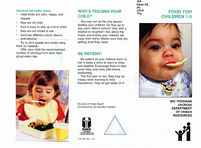Children eat better when: meal times are calm, happy, and
relaxed they are not tired food is easy to pick up and to chew they are not forced to eat food has different colors, flavors,
Try to limit sweets and avoid using them as rewards.
Offer your child the recommended number of servings from each food group every day.
WHO'S FEEDING YOUR CHILD?
You may not be the only person feeding your children. Do they go to day care? Attend school? Stay with a relative or neighbor? Ask about the meals and snacks your children eat away from home. Makes sure they are getting what they need.
BE PATIENT!
Be patient as your children learn to eat. It takes a while to learn to chew and swallow. Encourage them to take small bites and chew well before swallowing.
The fi rst year or two, they may be messy while learning to feed themselves. They do get better at it!
Division of Public Health Developed by the Nutrition Section
ili
DHR GEORGIA DEPARTMENT OF HUMAN RESOURCES
Form 3997 (Rev. 1-02)
FOOD FOR CHILDREN 1-5
WIC PROGRAM GEORGIA
DEPARTMENT OF HUMAN
RESOURCES
After the first birthday, children don't grow as fast as they did as babies. Their appetites usually slow down, too.
Most children will eat when they get hungry if they have not filled up on junk. Keep offering good, healthy food, and don't fight if your children won't eat.
The amount of food your child eats may change from day to day.
Is your child hooked on only one food?
This is common, so don't worry. Keep offering a variety of foods, and your child will learn to eat them.
EATING TIPS
How much? Portion sizes for children under four
may be about one-third smaller than adult portion sizes.
The portion size usually increases for children four and over.
How often? Children need several small meals
rather than three large ones.
Offer healthy snacks in-between meals.
'--
Fat T Sugars
Bread, Cereal, Rice &
Pasta -----' Group
Serving Sizes by Age
Foods
Age Serving Sizes
Milk & Milk Products
1-3
4 oz. fl. 3/4 oz. hard cheese
4-6
8 oz. 1 1/2 oz.
Meat, Poultry, Fish, Fruit Eggs, Nuts, Dry Beans,Peas
1-3
4-6 1-3
1 oz. equivalents 1 oz. meat, fish,
poultry
31. fruit 1/2 c. juice
Vegetables
4-6
1-3
fruit 1/2 c. 31. cooked juice 3/4 c 2/3 c. raw,
leafy
4-6
1/2 c. 1 c.
Grain Products
-
1-3
1/2 sl. bread 2 crackers
3/4 c. ice cream 1 1/2 c. 1 egg, 1/2 c. tunal 1/2 med. 1
salmon
apple/
31.
11/2c.1/2c.dry
chopped veg.
cereal
Fats, Oils and Sweets
4-6 All age groups
1 sl. 1 tsp. marg.=2 g. fat
4
1 1. mayo=11 g. fat
3/4 c. 1 1. salad dr=7 g. fat
1/4 c. cottage cheese
1/2 c.
2 1. peanut butter
1/2 banana 1
3T mashed 1/2 c. 1/4 c. cooked 1/2 c. 21. Sour Cream=6 g.
potatoes
cereal/pastalrice/grits fat
No. of Servings
4 oz. yogurt
8 oz.
1 oz. processed 2 oz. cheese
1/2 c. dried beans/ peas
1/2 orange 1
3 T potato 1/2 c. salad
1/2 pancake 1
13 oz. fruit drink=12 1. sugar
12 oz. cola=9 1. sugar
4 (16. oz. total)
2
3 oz. total 5 oz. 2
total
2
3
3
6
Your WIC foods - milk, cereal, eggs, cheese, juice - are excellent building blocks.
6
Use sparingly
I
